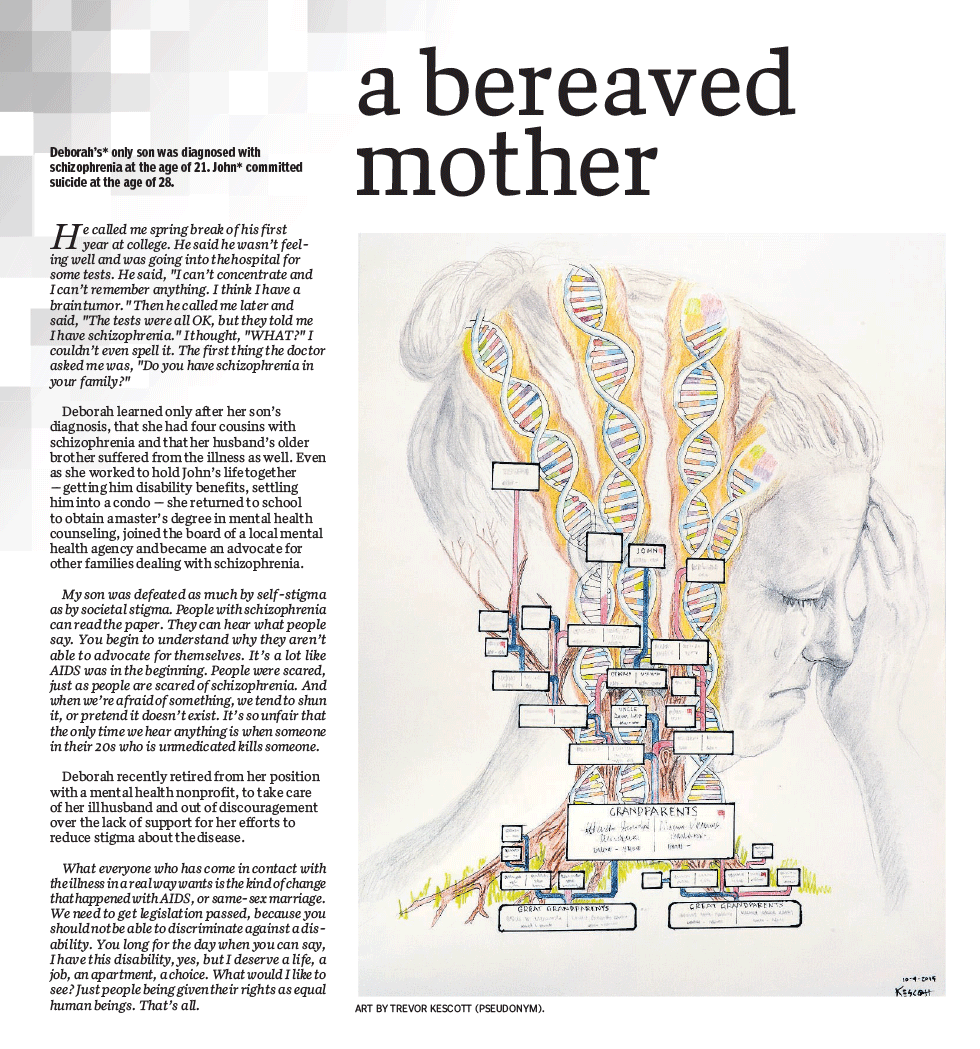The Sarasota Herald-Tribune rolled out an ambitious project on schizophrenia this weekend with a goal of reducing the stigma that surrounds the disease and a presentation online and in print that demands readers’ attention. The project, “The S Word: the Stigma of Schizophrenia,” is notable on several fronts.
It’s personal. The project—a package of stories about people with schizophrenia and their family members—is written by dance critic, arts writer and special projects reporter Carrie Seidman. In the first story, Seidman writes movingly in the first person about her son, 31-year-old Keaton, and his “jagged journey to stability”—in which she plays a tireless role. She also tells the story of another man and his mother navigating the labyrinth of mental illness. Both stories include full names and photos, but Seidman granted anonymity to the six other people she writes about, because the stigma is still so great. There’s no pivot in this project to policy or even a big feature narrative. It’s essentially an effort to humanize people with schizophrenia–a bit like an advocacy or awareness campaign.
“With schizophrenia, all you hear is when someone has committed a violent act,” Seidman told me. “Even bipolar has become somewhat accepted because celebrities have come out and said they have it. But with schizophrenia, there’s always a huge wave of casual and social media conversations about ‘that whacko’ and ‘lock ‘em up’ when something happens. I felt it was important to show there is a whole other side to this and really, it’s the larger side than the handful of people who do something violent.”
The presentation. The Herald-Tribune ran “The S Word” in print as a special Sunday section, with no ads and an effectively stark design. Because most of the people featured feared going public—Patrick O’Keefe changed his mind about participating in the project “twice over six months,” Seidman wrote– the editors told me they were initially unsure how they could illustrate the anonymous stories. What they came up with was creative and fitting with the advocacy tone of the package: They gave the pieces to a local artist who suffers from schizophrenia and asked him to draw pictures that reflected what he read.
“I think those are some of the most powerful pieces of the whole project,” projects editor Scott Carroll told me. I agree.
Image of one Herald-Tribune broadsheet page, courtesy of the paper. Drawing by Trevor Kescott (pseudonym). Click to view larger.
The online package is presented in a clean microsite the Herald-Tribune set up. Assistant managing editor* Tony Elkins explained that the paper’s in-house developer, Dak Le*, created a content management system using WordPress a couple years ago that makes it possible for the newsroom to easily highlight its big projects.
“We can go longform really fast,” Elkins said. “We’re always pushing the boundaries because we have a robust platform to build on.”
The Herald-Tribune has even retrofitted projects like the one I wrote about last year on guardianship cases. Though it was originally presented on the paper’s regular website, with its dated design, the staff was later able to give it its own microsite, to much better effect.
The timing. “The S Word” ran just a week after the Herald-Tribune devoted its entire front page to a joint project with the Tampa Bay Times, which I also wrote about, on the horrific conditions in Florida’s public mental hospitals. The two projects are quite different; the one on mental hospitals is classic watchdog journalism, exposing gross injustice, while the one on schizophrenia is more explanatory journalism. The editors told me the timing was accidental but not unconsidered. The mental hospitals investigation was originally scheduled to run a couple months ago but got pushed back.
“We talked about it and came to the conclusion that they sort of complemented each other,” Carroll said. “We thought this showed the other side.”
It does, particularly when Seidman writes about her son’s awful experience in hospital psychiatric wards. It would have been nice to tease Seidman’s project last week within the mental hospital investigation, giving readers notice that more was coming on the issue of mental illness.
As part of the advocacy aspect of the project, the Herald-Tribune hosted a public forum Tuesday night, described on the paper’s Facebook page as a “community conversation on mental illness.” Seidman called the turnout “overhwhelming” and the discussion “thoughtful” and “poignant.”
The Herald-Tribune succeded in bringing this “feared and loathed illness,” in Seidman’s words, into focus—in print, online, and in person.
*This post originally misstated Tony Elkins’ title and misspelled Dak Le’s name.
Susannah Nesmith is CJR’s correspondent for Florida, Georgia, and Alabama. She is a freelance writer based in Miami with more than 25 years working for regional and national outlets. Follow her on Twitter @susannahnesmith.


